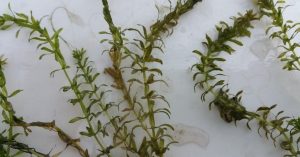By Catherine Farrell and Claire McMahon
This summer, the Finger Lakes PRISM Aquatic Invasive Species (AIS) Field Team, hosted by the Finger Lakes Institute at Hobart and William Smith Colleges, has been monitoring Cayuga Lake’s nearshore ecosystem. This science-driven team prioritizes early detection of aquatic invasive species (AIS) to provide rapid response to emerging invasive populations to better inform management of invasives in the lake.
On Cayuga Lake, the AIS Field Team monitors six locations near popular boat launches. These sites are areas of high concern because AIS can attach to watercraft and be transported from one waterbody to another. From June to August, the team performs monthly sampling efforts from kayaks within a half-mile radius of each boat launch. At each site, the team samples up to 300 points by tossing macrophyte sampling rakes into the water and pulling up submerged plants for identification and measurement. Both native and invasive plants are recorded, and AIS are reported to iMapInvasives, an online, GIS-based data management system.
The team also collects water quality data near each launch to gain further insights into local aquatic macrophyte ecology. These data help reveal how Cayuga Lake’s ecosystem changes over the season and from year to year, how it compares to other lakes, and can help determine which areas are most vulnerable to new invasions. Invasive species can adversely impact aquatic ecosystems, including macroinvertebrate and fish communities, so it is important to mitigate existing AIS-related issues and prevent further infestations on Cayuga Lake and other Finger Lakes. These programs are essential to Cayuga Lake to ensure it remains healthy and accessible for residents, boaters, swimmers, and nature lovers.
The Finger Lakes PRISM AIS Field Team has new staff leaders this year including a new program manager and AIS field coordinator. Catherine Farrell is the program manager and previously worked with AIS within two other NY PRISMs and recently completed her master’s degree in community ecology at Binghamton University. Claire McMahon is the new AIS field coordinator and has a background in conservation, invasive species management, and aquatic ecology. She has assisted with AIS research in other PRISMs and recently completed a master’s degree in Lake Management at SUNY Oneonta.
The AIS Field Team is excited to continue their work gathering data on aquatic invasive species throughout the Finger Lakes. Any questions, or concerns about AIS can be directed to Catherine Farrell at cfarrell@hws.edu.


